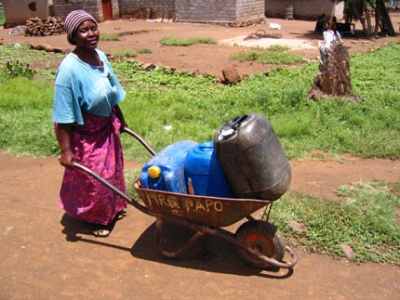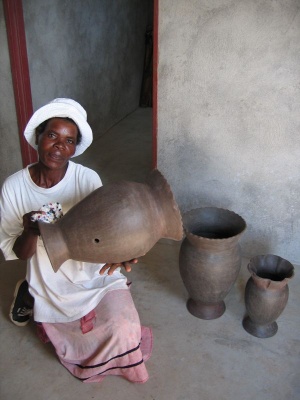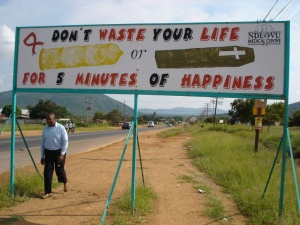Sekhukhune
Community based video – Adapting to multiple stressors in Limpopo – This video was made by drawing on fieldwork we did in Limpopo Province, South Africa, where we wanted to see what the different stressors were that people were exposed to and how they are linked to climate exposure.

Woman transporting water in Ga-Selala village, Sekhukhune (Photo: Gina Ziervogel)
Even though water stress is one of the key manifestations of climate variability and change in Sekhukhune District, it is generally not perceived as a climate issue alone. Rather, water scarcity is considered to be the result of a combination of insufficient and highly variable rainfall conditions, issues of equitable water resource management, and the absence of drinking water, bulk water and irrigation infrastructure that would enable the distribution of water to all rural villages and hospitals.
Many of the development issues in the district – the supply of basic services, irrigation for subsistence, small-scale market-oriented agriculture and commercial agriculture, and the expansion of the commercial mining sector – are highly dependent on water availability. The management of water resources is linked to livelihood security through direct impacts on agriculture and livestock at the individual and communal levels, and indirect impacts on employment opportunities and food prices. Food insecurity and a lack of money were identified as key concerns by many households. Most people interviewed highlighted the need to create employment opportunities and to improve water supplies for agricultural activities. However, the decisions relating to water use and distribution are made by stakeholders at the provincial and district levels and prioritise the growth of regional economic activities that do not necessarily reduce the high levels of poverty in rural communities, at least not in the shorter-term.
At the national and provincial levels there is awareness of the need to address climate impacts and adaptation and some assessments have highlighted the need for the development of adaptive strategies. However, no climate change impact and adaptation assessments have been undertaken at the district level to determine the implications for the water sector. At the local level there is evidence that people are developing adaptation strategies to changing patterns of water availability and the ever-prevalent stress of limited finance. People always have and will respond to stress in different ways but establishing the key adaptation strategies and set of actions associated with these strategies can help to provide a point of entry where support can be best utilized. If climate change accelerates, stress on rural livelihoods is likely to increase and it is critical that measures are put in place that support adaptation strategies that are climate-sensitive.

Women’s cooperative making clay pots in Ga-Selala village, Sekhukhune (Photo: Gina Ziervogel)
Because of an increase in the frequency of crop failures, many people are moving away from agriculture/horticulture and are instead seeking to engage in wage earning activities as an adaptation to water and climate stresses. As a consequence, less food is directly available to the household. People in the villages linked changes in food production and availability to decreased health, which is in turn linked to climate, water and economic/financial stresses. The price and availability of food on the informal and formal market fluctuates (often linked to climate variability) and can decrease the accessibility and affordability of (nutritious) foods. Households spending patterns have changed and this can impact on the quantity and quality of food consumed (which is a particular concern for people living with HIV). Although HIV/AIDS was mentioned as a key stress at the municipal level, it was not mentioned as a key stress in the villages where we worked. However, people did talk about the increase in home-based carers in response to increased health-care problems. If this could become a paid, regulated and better supported system this might be a very effective and beneficial sector for job creation.
An important response to lack of employment within the village is to migrate, even though it is seen by many as a last resort. Young people particularly tend to migrate in the hope of finding employment in one of the cities or mining areas. Whilst many people still living in the villages are considering migration, some do not have the opportunity to do so due to financial constraints or the lack of social networks in the target areas. Widespread rural-urban migration contributes to the generation of a range of urban risks through the growth of unplanned informal settlements on marginal land and the implications this entails, such as fire and flood risks, health and safety concerns, the erosion of traditional social networks, and the additional strain on urban municipalities to meet basic services for a rapidly growing poor urban population. Migration – as a rural adaptation strategy – is therefore generating new vulnerabilities or exacerbating existing vulnerabilities elsewhere. These linkages have not yet been investigated in South Africa and need to be investigated further in future research.
Adaptation strategies often occur in highly constrained circumstances and municipal support is needed to build adaptive capacity and to facilitate village-level development. Improved social safety nets and micro-finance schemes that empower people and are sensitive to their needs rather than generating increased dependency might be one way to achieve this. At the same time economic opportunities need to be created locally. This could be done by stimulating local businesses, adding value to locally produce, and creating markets.

AIDS awareness sign, Sekhukhune (Photo: Frank Thomalla)
HIV/AIDS is of considerable national concern as it has many links to poverty, livelihood security and economic development. In Sekhukhune the figures are lower than the national average, yet much remains to be done to curb the spread of the disease. Due to the limited duration of this study, we were not able to gain much information about these issues at the village level. The government recognises the potential scale of the challenge, especially in the areas where the mining is expected to grow rapidly. It is critical that measures are put in place now to curb/minimise the potential negative impacts of the disease, otherwise it will undermine development in the long term.
There are differing perceptions regarding the nature and scale of challenges and how they should be addressed. While some of the prioritised issues are the same (e.g. the need for employment, addressing water constraints and the continued roll-out of basic services) the scale at which they are viewed and sought to be addressed is very different and there are limited attempts to bridge these scales.
The findings indicate that water scarcity and limited economic opportunities are two major constraints to development at both the village and district scale that undermines adaptive capacity. People to a large extent relate both climate stress and food insecurity back to these two dominant stressors. This highlights the need for integrated responses to support local adaptation that departs from hegemonic sectoral approaches. It also requires improved and increased communication between government and local communities to facilitate the integration of strategies being implemented at different scales and better align expectations. Municipal government needs to carefully assess the likely environmental, social and economic impacts of investing in different sectors, incorporating a view on climate change and prioritizing water saving and wealth distributing options with the aim of minimizing future vulnerability.
For more on the findings of this work see: Adapting to multiple stresses in Sekhukhune, South Africa
Related Pages
Adapting to multiple stresses in Sekhukhune, South Africa
Effective use of climate science to improve adaptation in Africa
(0) Comments
There is no content